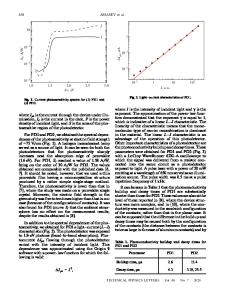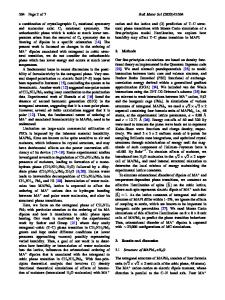Low-temperature-deposited SnO 2 films for efficient planar CH 3 NH 3 PbI 3 photovoltaics
- PDF / 4,017,786 Bytes
- 14 Pages / 595.276 x 790.866 pts Page_size
- 30 Downloads / 335 Views
Low-temperature-deposited SnO2 films for efficient planar CH3NH3PbI3 photovoltaics Kai Zhang1, Jinxia Duan1,*, Feng Liu1, Jun Zhang1, and Hao Wang1,* 1
Hubei Key Laboratory of Ferro and Piezoelectric Materials and Devices, Faculty of Physics and Electronic Science, Hubei University, Wuhan 430062, People’s Republic of China
Received: 6 February 2020
ABSTRACT
Accepted: 30 August 2020
Low-temperature-synthesized electron transport layers (ETLs) are in demand for the industrialization and flexibility of perovskite solar cells (PeSCs). SnO2 ETLs are prepared via chemical bath deposition at low temperature. Uniform SnO2 ETLs with high crystallinity and transmittance are obtained from a 0.3 M SnCl4 solution through a 100 °C heat treatment. They effectively transport electrons and weaken recombination loss in SnO2-based photovoltaics. SnO2based PeSCs exhibit a power conversion efficiency (PCE) of 16.92% with a shortcircuit current density (JSC) of 21.48 mA cm-2 and a fill factor (FF) of 73.62%. Secondary bath modification is proposed to mend the surface pinholes of SnO2 ETLs and boost the photoelectric properties of SnO2-based devices. The photovoltaic performance of the devices based on modified SnO2 (2-SnO2) films exhibits an impressive increase compared with unembellished ones due to less pinholes and suppressed surface defects. The open circuit voltage (VOC) and FF of 2-SnO2-based photovoltaics are enhanced to 1.10 V and 76.71%, respectively, resulting in PCE to 18.04%. Simultaneously, the dark current and hysteresis of 2-SnO2-based PeSCs are reduced because the secondary bath refines the surface nanoparticles of ETLs, passivates defects and reduces charge recombination at ETL/perovskite interfaces. Accordingly, 2-SnO2-based photovoltaics with a large area (* 1 cm2) achieves 12.91% efficiency.
Published online: 15 September 2020
Ó
Springer Science+Business
Media, LLC, part of Springer Nature 2020
Introduction Since Kojima group pioneered the powerful application of organic–inorganic hybrid perovskite materials in photovoltaic devices, perovskite solar cells (PeSCs)
have ignited an unprecedented upsurge [1–4]. The power conversion efficiencies (PCE) of PeSCs have currently exceeded 24% [5]. Two familiar device configurations in PeSCs are the planar and mesoporous structures [5, 6]. A prominent genre in delivering high-efficiency and stable power output
Handling Editor: N. Ravishankar.
Address correspondence to E-mail: [email protected]; [email protected]
https://doi.org/10.1007/s10853-020-05216-y
678 for PeSCs is the mesoporous TiO2 (m-TiO2) structure [5, 7–10]. However, m-TiO2 requires high-temperature annealing ([ 450 °C), which hinders cost reduction and process simplification [7–10]. Thus, the exploration of planar PeSCs is placed on the agenda as a research issue [11–13]. Yella et al. presented a low-temperature MAPbI3 PeSC based on rutile TiO2 electron transport layer (ETL) via chemical bath deposition (CBD). The rutile TiO2 ETL had a tight large-interface bonding with the MAPbI3 film, which extracted p
Data Loading...











